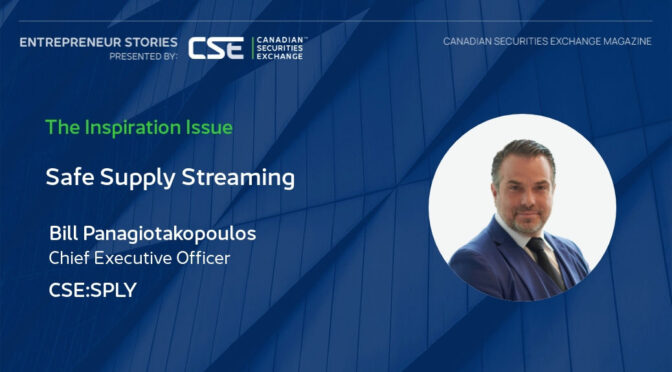The Western United States has long been one of the world’s most attractive jurisdictions for mineral exploration. The Carlin Trend and other well-known districts provide the prospectivity, while local familiarity with mining and supportive policy give exploration companies comfort that they can realize value from any deposits they might discover.
Headwater Gold (CSE:HWG; OTCQB:HWAUF) is advancing multiple projects in two western states – Nevada and Idaho – and its team could not be happier with what it is seeing.
“There are certainly a lot of tailwinds for the mining industry in the western part of the U.S. right now,” Headwater Gold President and Chief Executive Officer Caleb Stroup tells Canadian Securities Exchange Magazine. “And that’s especially true in jurisdictions like Nevada that have a strong mining culture in existence already. The local communities understand mining, the permitting systems are in place, and we’re seeing signs of improvement in timelines, as directed by the current administration.”
Headwater’s business model blends the traditional approach of direct-funded discovery with a prospect generator strategy designed to broaden exploration exposure while minimizing shareholder dilution.
“Our view is that, especially in early-stage exploration, you need to take a portfolio approach and have multiple targets that are being tested at any given time. That simply gives you a better probability for making a discovery,” Stroup explains.
The CEO also acknowledges the challenges for juniors in relying exclusively on public or private markets to raise capital for exploration.
“There is a pool of capital in larger companies looking for good exploration ideas, especially in places like Nevada, which is one of the best, if not the best, mining jurisdictions in the world,” Stroup says.
“We chose to build something that was a combination of raising money ourselves to explore our 100% owned projects and leveraging partner-funded capital to advance more projects, to offer scale to our exploration and shareholders.”
For a company of its size, Headwater Gold’s lineup of partners is impressive. One of the most notable is its two-project deal in Nevada with Newmont Corporation, the world’s largest gold producer.
Originally signed with Australian producer Newcrest Mining, the agreement was carried forward following Newmont’s acquisition of Newcrest in 2023.
Under the arrangement, Newmont is earning into Spring Peak and Lodestar, two epithermal projects in Nevada’s Walker Lane Trend, which has attracted attention in recent years following a Tier 1 discovery made by AngloGold Ashanti at its Silicon Project.
Centerra Gold, a major gold producer, also became a key partner last year, taking a 9.9% equity stake in Headwater.
The numbers behind Headwater’s partnerships are significant. Using Newmont’s earn-in deal for the Spring Peak project as an example, Stroup says that the company always starts with a minimum commitment.
At Spring Peak, this was US$5 million minimum in exploration work, as part of a $15 million Stage 1 earn-in for 51% ownership. If that threshold is reached, Newmont can earn up to 75% by completing a prefeasibility study and granting Headwater a royalty, specifically a 2% net smelter return (NSR) on staked ground or 1% on small third-party parcels, following an additional US$40 million in exploration work.
“These are fairly big dollar numbers, both in terms of the minimum exploration commitment but also the ongoing earn-in exploration structure,” Stroup says.
On July 22 of this year, Headwater signed a letter of intent with OceanaGold covering three projects in northern Nevada: TJ, Jake Creek, and Hot Creek. The deal includes a minimum spending commitment by OceanaGold of US$2.5 million across the projects in the first two years of the agreement. OceanaGold could earn 75% of the projects with total exploration spending of US$65 million, completion of prefeasibility studies, and the granting to Headwater of 1% NSRs.
In the case of both the Newmont agreement and the OceanaGold partnership, Headwater is the project operator, collecting a 10% management fee on all exploration work it carries out.
“That allows us to have fairly close technical control as to what’s taking place on the ground,” Stroup says. “It also provides a mechanism for us to fund a lot of our ongoing costs at the corporate level with that 10% management fee, resulting overall in a very low burn rate, which over the last couple of years has been nearly net neutral despite all the activity in the portfolio.”
With five projects currently under partnership, Headwater is also advancing its 100% owned projects. Two standout assets are Midas North in Nevada and Crane Creek in Idaho.
At Midas North, Headwater holds the northern end of the historic Midas Mining District. Immediately to the south of Headwater’s land package is the Midas mine complex, where over 2 million ounces of gold and over 25 million ounces of silver were extracted from high-grade epithermal veins by various operators between 1998 and 2019.
Despite its proximity to the past-producing mine, the property is largely untested. Headwater’s early drilling and geologic mapping have defined a preserved alteration cell, indicating a potentially intact epithermal system at depth.
“There are some very interesting targets that are emerging and we think we really have a shot at a Midas-type discovery,” Stroup states.
Meanwhile, at Crane Creek, Headwater sees similar overlooked potential. Located in western Idaho, the project features a 4-kilometre-long gold anomaly and historic drilling that returned several high-grade intercepts.
Headwater’s recent work has also identified a higher-grade vein system which was previously untested. Surface sampling has returned multiple samples exceeding 5 grams per tonne gold, suggesting the potential for a vein-hosted discovery, according to Stroup.
With partner funding and internal targets lined up, Headwater is preparing for multiple drilling programs in the coming year.
Notably, Newmont-funded exploration is expected to kick off at the Lodestar project, located at the northern end of the Aurora Mining District and adjoining Spring Peak.
“This is the target area that we’ve been developing for the last couple of years now and remains probably the highest-priority undrilled target in the district, in my view at least,” Stroup says. “We’re waiting for one final permit to get going this fall here, and that’s progressing through. So that’ll be a good piece of news to watch for as that program develops.”
As part of its newly announced partnership with OceanaGold, it is expected that drilling will commence at the TJ project in the latter half of 2025. This will bring Headwater’s partner-funded drill programs to at least two by year-end.
Behind Headwater’s success is a team of veteran geologists with experience in both major and junior exploration.
Stroup himself spent years in the field with Kinross Gold before founding Headwater. Chairman Alistair Waddell held senior roles at Kinross and has decades of experience in global gold exploration. The company recently added Fraser MacCorquodale, former Global Head of Exploration at Newcrest, to its board.
This technical credibility has been a key factor in building trust with major partners, Stroup believes.
“Our experience with the majors at the corporate level is in large part the reason why we’ve been able to build their trust and establish so many partnerships. With these earn-in partnerships, we can give shareholders a great shot at a new discovery and exploration upside but minimize the dilution required to get there.”
This story was featured in Canadian Securities Exchange Magazine.
Learn more about Headwater Gold at https://headwatergold.com/.










